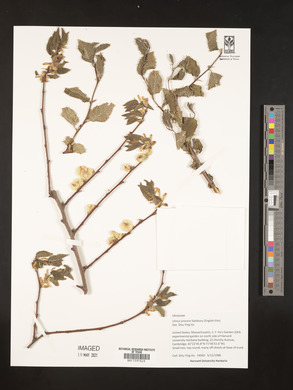Ulmus procera
|
|
|
|
Family: Ulmaceae
English Elm
[Ulmus campestris L., moreUlmus carpinifolia Gleditsch, Ulmus minor Mill.] |
Trees , to 40 m; crowns open. Bark grayish brown, deeply ridged, flaking. Wood hard. Branches: old-growth branchlets with corky ridges; twigs reddish brown, villous to scabrous, old-growth branchlets with corky ridges. Buds ovoid; scales dark brown, sparsely pubescent, marginally pale-ciliate. Leaves: petiole 3-12 mm, villous to scabrous. Leaf blade broadly lanceolate-elliptic to ovate, (3-)7-10 × (3-)4-6(-10) cm, base strongly oblique, not covering petiole, margins doubly serrate, apex acute to acuminate; surfaces abaxially villous with woolly tufts in vein axils, pale in contrast to adaxial surface, adaxially dark green, glabrous to sparsely scabrous, margins not ciliate. Inflorescences dense clusters of subsessile flowers borne on lateral shoots resembling short racemes, flowers and fruits not pendulous. Flowers: calyx green to reddish purple or tan, shallowly lobed, lobes 5-8, marginally villous; stamens 3-5(-6); anthers dark brown, globose; stigmas white, puberulous, persistent in fruit, slender lobes incurved. Samaras light brown, darker brown to red in area covering seed, orbiculate, about as long as broad, 0.9-1.8 × 0.9-1.6 cm, broadly winged, glabrous except for pubescence along margin of apex, apex shallowly notched. Seeds thickened, not inflated. 2 n = 28. Flowering early-late spring. Persisting, sometimes naturalizing locally where species has been planted; 0-400 m; introduced; Ont.; Calif., Conn., Ill., Mass., Mo., N.Y., R.I.; native to Europe. In the absence of carefully documented naturalized populations, the North American distribution of Ulmus procera is very poorly known. It is locally established in British Columbia, Arizona, Louisiana, Maryland, and Michigan. It has been reported from Georgia, North Carolina, Virginia, and West Virginia. Off-shoots from the root systems are often found close to planted trees, forming dense clones, especially in and around urban centers. Some authors have combined Ulmus minor Miller and U . procera Salisbury. This treatment follows that of Tutin and colleagues (T. G. Tutin et al. 1964-1980, vol. 1, pp. 65-66), in which the species were regarded as separate. Reports of Ulmus minor Miller, in the strict sense, in North America are not confirmed. Hybrids of Ulmus procera and U . glabra are reported from New York (R. S. Mitchell 1988) and may be spreading. Both U . procera and U . glabra are involved in the parentage of Dutch elm, Ulmus × hollandica Pallas.
Large tree to 40 m tall, trunk diameter to 1 m Leaves: alternate, long-stalked (leafstalk hairy), dark green, paler beneath, 5 - 8 cm long, 3 - 5 cm wide, and broadly elliptical with an asymmetrical base and short-pointed tip. It is also double-toothed, rough above, and softly hairy beneath with tufts in the vein axils. In autumn the leaves turn yellow. Flowers: tightly clustered along twigs, dark red, 3 mm long. Fruit: single-seeded, winged (samara), short-stalked, about 1 cm wide, round, flat, and notched at the tip. Bark: gray and deeply furrowed into rectangular plates. Twigs: thin, dark reddish brown, and hairy when young. Older branchlets may have corky wings. Buds: dark smoky brown, 2 - 3 mm long, egg-shaped, slightly hairy. Form: dense and broadly rounded with ascending branches. Trunk straight and persisting halfway or more into the crown. Similar species: In the Chicago Region, Ulmus procera is distinguished from the native elms by having much smaller leaves (5 - 8 cm long). Leaves of U. thomasii may be of similar size, but they differ by having a nearly symmetrical base. In addition, U. thomasii has hairy samaras. The non-native U. pumila differs by having hairless leaves that are not distinctly asymmetrical at the base or doubly-toothed. The hybrid U. x notha differs by having middle bud scales fringed with white hairs and terminal bud scales fringed with reddish brown hairs. Leaves of the genus Celtis, which are similar in appearance, exhibit three main veins arising from the base of each blade. Flowering: April Habitat and ecology: Ulmus procera, brought here from Europe, was planted extensively in colonial times and has since escaped in more than a dozen states. Reproducing from suckers, it apparently is a sterile species. It is not known to have naturalized in the Chicago Region, but might be seen in moist soils along roadsides, forest borders, and thickets as an escape from cultivation. Occurence in the Chicago region: non-native Notes: This elm, as well as all native elm species, is susceptible to Dutch elm disease and phloem necrosis. See link to Dutch elm disease below. Etymology: Ulmus is the Latin word for elm. Procera means tall. Author: The Morton Arboretum |












































































